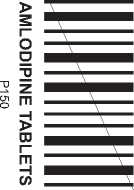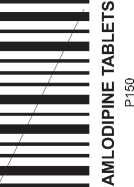Amlodipine 5 Mg Tablets
Out of date information, search anotherPharmacode position may change as per Supplier's m/c requirement &additional small pharma code may appear on the front / back panel
J L


PACKAGE LEAFLET: INFORMATION FOR THE USER
Amlodipine 5 mg tablets Amlodipine 10 mg tablets
Amlodipine
Read all of this leaflet carefully before you start taking this medicine.
- Keep this leaflet. You may need to read it again.
- If you have any further questions, ask your doctor or pharmacist.
- This medicine has been prescribed for you. Do not pass it on to others. It may harm them, even if their symptoms are the same as yours.
- If any of the side effects gets serious, or if you notice any side effects not listed in this leaflet, please tell your doctor or pharmacist.
In this leaflet:
1. What Amlodipine is and what it is used for
2. Before you take Amlodipine
3. How to take Amlodipine
4. Possible side effects
5. How to store Amlodipine
6. Further information
1. WHAT AMLODIPINE IS AND WHAT IT IS USED FOR
Amlodipine contains the active substance amlodipine which belongs to a group of medicines called calcium antagonists.
Amlodipine is used to treat high blood pressure (hypertension) or a certain type of chest pain called angina, a rare form of which is Prinzmetal's or variant angina.
In patients with high blood pressure your medicine works by relaxing blood vessels, so that blood passes through them more easily. In patients with angina Amlodipine works by improving blood supply to the heart muscle which then receives more oxygen and as a result chest pain is prevented. Your medicine does not provide immediate relief of chest pain from angina.
2. BEFORE YOU TAKE AMLODIPINE
Do not take Amlodipine
- If you are allergic (hypersensitive) to amlodipine, or any of the other ingredients of your medicine listed in section 6, or to any other calcium antagonists. This may be itching, reddening of the skin or difficulty in breathing.
- if you have severe low blood pressure (hypotension)
- If you have narrowing of the aortic heart valve (aortic stenosis) or cardiogenic shock (a condition where your heart is unable to supply enough blood to the body).
- if you suffer from heart failure after a heart attack Take special care with Amlodipine
You should inform your doctor if you have or have had any of the following conditions:
- Recent heart attack
- Heart failure
- Severe increase in blood pressure (Hypertensive crisis)
- Liver disease
- You are elderly and your dose needs to be increased Use in children and adolescents
Amlodipine has not been studied in children under the age of 6 years. Amlodipine should only used for hypertension in children and adolescents from 6 years to 17 years of age (see section 3).
For more information, talk to your doctor.
Taking other medicines
Please tell your doctor or pharmacist if you are taking or have recently taken any other medicines, including medicines obtained without a prescription.
Amlodipine may affect or be affected by other medicines, such as:
- ketoconazole, itraconazole (anti-fungal medicines)
- ritonavir, indinavir, nelfinavir (so called protease inhibitors used to treat HIV)
- rifampicin, erythromycin, clarithromycin (antibiotics)
- hypericum perforatum (St. John's Wort)
- verapamil, diltiazem (heart medicines)
- dantrolene (infusion for severe body temperature abnormalities)
- simvastatin (medicine for high blood cholesterol)
Amlodipine may lower your blood pressure even more if you are already taking other medicines to treat your high blood pressure.
Taking Amlodipine with food and drink
Grapefruit juice and grapefruit should not be consumed by people who are taking Amlodipine . This is because grapefruit and grapefruit juice can lead to an increase in the blood levels of the active ingredient amlodipine, which can cause an unpredictable increase in the blood pressure lowering effect of Amlodipine.
Pregnancy
The safety of amlodipine in human pregnancy has not been established. If you think you might be pregnant, or are planning to get pregnant, you must tell your doctor before you take Amlodipine.
Breast-feeding
It is not known whether amlodipine is passed into breast milk. If you are breast-feeding or about to start breast-feeding you must tell your doctor before taking Amlodipine.
Ask your doctor or pharmacist for advice before taking any medicine.
Driving and using machines
Amlodipine may affect your ability to drive or use machines. If the tablets make you feel sick, dizzy or tired, or give you a headache, do not drive or use machines and contact your doctor immediately.
3. HOW TO TAKE AMLODIPINE
Always take Amlodipine exactly as your doctor has told you. You should check with your doctor or pharmacist if you are not sure.
The usual initial dose is Amlodipine 5 mg once daily. The dose can be increased to Amlodipine 10 mg once daily.
Your medicine can be used before or after food and drinks. You should take your medicine at the same time each day with a drink of water. Do not take Amlodipine with grapefruit juice.
Use in children and adolescents
For children and adolescents (6-17 years old), the recommended usual starting dose is 2.5 mg a day. The maximum recommended dose is 5 mg a day. Amlodipine 2.5 mg is not currently available and the 2.5 mg dose cannot be obtained with Amlodipine 5 mg tablets as these tablets are not manufactured to break into two equal halves.
It is important to keep taking the tablets. Do not wait until your tablets are finished before seeing your doctor.
If you take more Amlodipine than you should
Taking too many tablets may cause your blood pressure to become low or even dangerously low. You may feel dizzy, lightheaded, faint or weak. If blood pressure drop is severe enough shock can occur. Your skin could feel cool and clammy and you could lose consciousness. Seek immediate medical attention if you take too many Amlodipine tablets
If you forget to take Amlodipine
Do not worry. If you forget to take a tablet, leave out that dose completely. Take your next dose at the right time. Do not take a double dose to make up for a missed dose.
If you stop taking Amlodipine
Your doctor will advise you how long to take your medicine. Your condition may return if you stop using your medicine before you are advised.
If you have any further questions on the use of this medicine, ask your doctor or pharmacist.
4. POSSIBLE SIDE EFFECTS
Like all medicines, Amlodipine can cause side effects, although not everybody gets
them.
Visit your doctor immediately if you experience any of the following very rare, severe
side effects after taking this medicine.
• Suddenwheeziness, chest pain, shortness of breath or difficulty in breathing
• Swellingof eyelids, face or lips
• Swellingof the tongue and throat which causes great difficulty breathing
• Severeskin reactions including intense skin rash, hives, reddening of the skin over your whole body, severe itching, blistering, peeling and swelling of the skin, inflammation of mucous membranes (Stevens Johnson Syndrome) or other allergic reactions
• Heartattack, abnormal heart beat
• Inflamedpancreas which may cause severe abdominal and back pain accompanied with feeling very unwell
The following common side-effects have been reported. If any of these cause you
problems or if they last for more than one week, you should contact your doctor.
Germany
Spain
Ireland
Italy
Malta
Poland
Portugal
Romania
Sweden
United Kingdom
Common: affects 1 to 10 users in 100
• Headache, dizziness, sleepiness (especially at the beginning of treatment)
• Palpitations (awareness of your heart beat), flushing
• Abdominal pain, feeling sick (nausea)
• Ankleswelling (oedema), tiredness
Other side-effects that have been reported include the following list. If any of these get serious, or if you notice any side-effects not listed in this leaflet, please tell your doctor or pharmacist.
Uncommon: affects 1 to 10 users in 1,000
• Moodchanges, anxiety, depression, sleeplessness
• Trembling, taste abnormalities, fainting, weakness
• Numbness or tingling sensation in your limbs; loss of pain sensation
• Visualdisturbances, double vision, ringing in the ears
• Lowbloodpressure
• Sneezing/running nose caused by inflammation of the lining of the nose (rhinitis)
• Alteredbowel habits, diarrhoea, constipation, indigestion, dry mouth, vomiting (being sick)
• Hairloss,increased sweating, itchy skin, red patches on skin, skin discolouration
• Disorderin passing urine, increased need to urinate at night, increased number of times of passing urine
• Inabilitytoobtain an erection; discomfort or enlargement of the breasts in men
• Weakness, pain, feeling unwell
• Jointormuscle pain, muscle cramps, back pain
• Weightincrease or decrease Rare: affects 1 to 10 users in 10,000
• Confusion
Very rare: affects less than 1 user in 10,000
• Decreased numbers of white blood cells, decrease in blood platelets which may result in unusual bruising or easy bleeding (red blood cell damage)
• Excesssugar in blood (hyperglycaemia)
• A disorderof the nerves which can cause weakness, tingling or numbness
• Cough,swelling of the gums
• Abdominal bloating (gastritis)
• Abnormalliver function, inflammation of the liver (hepatitis), yellowing of the skin (jaundice), liver enzyme increase which may have an effect on some medical tests
• Increasedmuscle tension
• Inflammation of blood vessels, often with skin rash
• Sensitivityto light
• Disorderscombining rigidity, tremor, and/or movement disorders
If any of the side effects gets serious, or if you notice any side effects not listed in this leaflet, please tell your doctor or pharmacist.
Not all pack sizes may be marketed.
Marketing Authorisation Holder
Milpharm Limited Ares, Odyssey Business Park West End Road South Ruislip HA4 6QD United Kingdom
Manufacturer
APL Swift Services (Malta) Limited HF 26, Hal Far Industrial Estate, Hal Far Brizebbugia BBG 3000 Malta
This medicinal product is authorised in the Member States of the EEA under the following names:
Amlodipin Aurobindo 5 mg/ 10 mg Tabletten Amlodipino Aurobindo 5 mg/ 10 mg comprimidos EFG Amlodipine Aurobindo 5 mg/ 10 mg tablets Amlodipina Aurobindo 5 mg/10 mg compresse Amlodipine Aurobindo 5 mg/ 10 mg Tablets Amlodipine Aurobindo Amlodipina Aurobindo
Amlodipina Aurobindo 5 mg/ 10 mg comprimate Amlodipin Aurobindo 5 mg/ 10 mg tabletter Amlodipine 5 mg/ 10 mg tablets
This leaflet was last approved in 06/2012.
P150
5. HOW TO STORE AMLODIPINE
Keep out of the reach and sight of children.
This medicinal product does not require any special storage conditions.
Do not use Amlodipine after the expiry date which is stated on the carton after Exp. The expiry date refers to the last day of the month.
Medicines should not be disposed of via wastewater or household waste. Ask your pharmacist how to dispose of medicines no longer required. These measures will help to protect the environment.
6. FURTHER INFORMATION
What Amlodipine contains
- The active substance is amlodipine as amlodipine besilate.
- The other ingredients are microcrystalline cellulose, calcium hydrogen phosphate, sodium starch glycolate, magnesium stearate.
What Amlodipine looks like and contents of the pack
5 mg: white or almost white, flat, bevelled edges, barrel-shaped tablet debossed with "C" on one side and "58" on the other side.
10 mg: white or almost white, flat, bevelled edges, round tablet debossed with "C" on one side and "59" on the other side.
PVC/ PVdC-Aluminium blister.
7, 10, 14, 15, 20, 28, 30, 50, 56, 60, 84, 90, 98, 100, 120, 200, 250, 300 and 500 tablets.